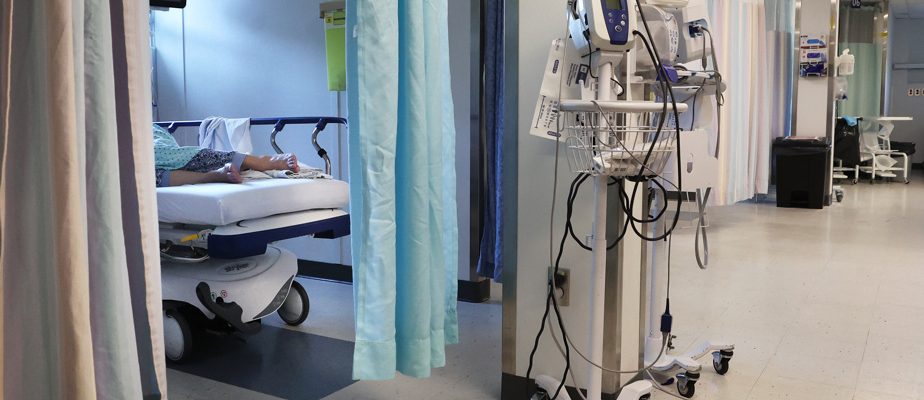(Montreal and Quebec) While “all ministerial attention was focused” on Christian Dubé’s vast reform, the health network “completely froze” and the situation in emergencies “deteriorated dramatically », denounce the emergency leaders of Quebec.
In a sharp letter addressed to the Minister of Health, the Regroupement des chefs d’urgence du Québec (RCUQ) deplores that emergencies have become “out of control”.
“We have challenged you, as well as your team, several times in recent months, but inertia remains palpable at all decision-making levels and the crisis is only getting worse,” writes the president of the group, the DD Marie-Maud Couture.
She adds that “all ministerial attention was focused on Bill 15 and the reorganization of the health system, the network has completely frozen.” The minister’s reform was adopted under gag order last Saturday, after 238 hours in parliamentary committee.
The alarming observation from Quebec’s emergency chiefs comes at a time when emergencies in Greater Montreal are under pressure. The Press reported last week that two patients had died in the crowded emergency room of the Anna-Laberge hospital in Châteauguay. Investigations are open1.
However, “the recent deaths in waiting rooms, as publicized as they are, are only the tip of the iceberg”, writes the DD Sewing.
Christian Dubé has also been visiting emergency rooms since last week, the minister’s office said on Friday.
“The situation in our emergency rooms concerns us. We follow it every day with the teams. Our role is to make sure we handle the urgent and work on the important at the same time. We have all the people in place to do it,” we assured.
In the hours following the adoption of his reform, Mr. Dubé admitted that the study of the bill had been “excessively time-consuming”.
“I can tell you that I will have time to return to the field to see what is happening in the hospitals,” he said.

Mixed effects of the crisis unit
In an interview, the DD Marie-Maud Couture admits that the crisis unit deployed last year by the minister to relieve emergency congestion “had made it possible to make improvements in certain establishments”, especially at the start of 2023.
But these measures then ran out of steam, according to her. With the tabling of Bill 15 in March, the meetings of the crisis unit were less frequent, as reported last week The Press.
“Today, we are as we were before the crisis unit,” said the president of the Association of Emergency Medicine Specialists, Dr.r Gilbert Boucher, who deplored that the Ministry had “regained control” of the cell and “discarded” the doctors.
The situation in the emergency room is indeed difficult these days.

The DD Couture affirms that since August, associations of emergency doctors have repeatedly alerted ministerial teams so that solutions can be found to emergency room congestion.
We feel like we can’t make things happen.
The DD Marie-Maud Couture, president of the Regroupement des chefs d’urgence du Québec
Christian Dubé also had to defend his management of the crisis in the emergency room after the two deaths that occurred at the Anna-Laberge hospital, replying that health establishments were slow to implement the measures recommended by the crisis unit.
In October, the minister appointed an “access coordinator” to the front line who took over the mission of the crisis unit. The former CEO of the CIUSSS de la Capitale-Nationale Michel Delamarre led meetings Monday and Friday on the subject of emergencies, according to our information.
“The team committed to fluidity goes into the field and works with network stakeholders,” maintains Mr. Dubé’s office. “The solutions are not implemented everywhere and the role of this team is precisely to ensure that silos are broken down and that coordination between establishments is improved. »
“Pious wishes”, according to the RCUQ
For the RCUQ, “the response to this now permanent crisis […] often comes down to wishful thinking or very complex solutions aimed at diverting mildly ill ambulatory patients from emergency rooms, patients who contribute nothing to congestion on stretchers, and whose prognosis is in no way at stake.”
Data from the Dashboard of the Ministry of Health and Social Services (MSSS) also show that the number of hospital beds occupied by patients who no longer need hospital care (NSA) has been increasing steadily since months.

These beds are not available for emergency room patients who need to be hospitalized. Consequence: patients spend a very long time in the emergency room, on stretchers, before getting a bed on the upper floors. “In certain emergencies, we start in the morning with 100% of the stretchers occupied by hospitalized patients…” notes the DD Sewing.
“To date, very little effort has been made to address the root cause of overcrowding, the use of emergency stretchers by hospitalized patients, and although there have been guidelines in connection with hospital overcapacity, accountability and the application of the various contingency plans have remained very theoretical,” we write in the letter.
In addition to the return of respiratory viruses, strike days in the health sector are contributing to a certain slowdown elsewhere on the floors. You should know that under a judgment of the Administrative Labor Court, emergency activities are maintained at 100%, despite the walkout.
